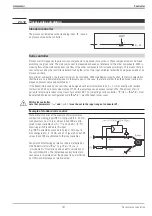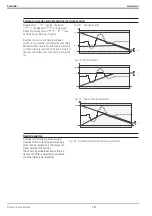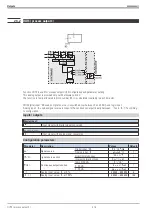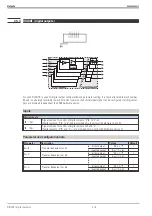
Configuration
Description
Values
Default
Type
0...20 mA
0...20mA
t
4...20 mA
4...20mA
Transducer 0...1000
[
Pot.trans.
Fail
Fail function off
disabled
Digital output
fail
= 1,
y1
=
x100
Upscale
t
Digital output
fail
= 1,
y1
=
x0
Downscale
Digital output
fail
= 1,
y1
=
XFail
Subst.val.
Xkorr
Measured value correction off
off
t
Measured value correction adjustable
on
x0
Physical value at 0%
only effective with standard signals
(0/4..20mA or 0/2..10V)
-29999 ... 999 999
0
x100
Physical value at 100%
-29999 ... 999 999
100
XFail
Substitute value with sensor error
-29999 ... 999 999
0
Tfm
Filter time constant [s]
0 ... 999 999
0,5
Input value conditioning
Before the pre-filtered (time constant ...; limiting fre-
quency ...) analog input signals are available as digi-
tized measurement values with physical quantity,
they are subjected to extensive input value process-
ing.
Input circuit monitor
q
Transducers
are monitored for break
and short circuit.
q
Current signals
Out-of-range monitoring (I > 21,5 mA) with current signals (0/4...20 mA) and
short-circuit monitoring (I < 2 mA) with “life zero” signals are provided.
Sensor errors are output as digital output (
fail
). In case of error, statuses ‘
Upscale
‘, ‘
Downscale
‘ or
‘
Subst.val
‘ defined in the configuration (
Fail
) can be used for the input circuit.
Scaling
The mA standard signals are scaled according the the physical measuring range of the transmitter (
x0
,
x100
). With
potentiometric transducer measurements, “calibration” is according to the proven method. Bring the transducer to start
and then to end position and “calibrate” to 0 % or 100 % by key pressure. The calibration principle corresponds to scal-
ing, whereby gradient and zero offset are calculated automatically by the firmware.
Filter
A 1st order filter is adjustable in addition to filtering in the analog part of each input signal.
Sampling intervals
The sampling interval for INP6 is 400ms.
Measured value correction
Measured value correction can be used for various types of measurement correction.
Pre-requisite:
configuration
XKorr
=
ein
In most cases, the relative rather than the absolute accuracy and reproducibility are of interest, e.g.:
-measurement error compensation in a working point (set-point control)
-minimization of linearity errors within a limited operating range (variable set-point)
-correspondence with other measuring facilities (recorders, indicators, PLCs, ...)
-compensation of sensor, transmitter, etc. sample differences.
The measured value correction is designed both for zero offset, gain matching and for both. It corresponds to scaling mx+b,
with the difference that the KS98 firmware calculates gain m and zero offset b from the defined value pairs for process value
(
x1in
;
x2in
) and set-point (
x1out
;
x2out
) of two reference points.
9499 040 50611
Inputs
211
AINP6 ( analog input 6 )
Summary of Contents for KS 98
Page 8: ...Description 9499 040 50611 Construction 8...
Page 10: ...Important technical data 9499 040 50611 Further external in and outputs 10...
Page 12: ...Versions 9499 040 50611 I O modules for units with modular option c basic card 12...
Page 14: ...Front view 9499 040 50611 14...
Page 16: ...Mounting 9499 040 50611 16...
Page 26: ...Maintenance 9499 040 50611 Further information 26...
Page 36: ...Scaling and calculating functions 9499 040 50611 LG10 10s logarithm 36...
Page 74: ...Signal converters 9499 040 50611 MEAN mean value formation 74...
Page 128: ...KS98 I O extensions with CANopen 9499 040 50611 RM_DMS strain gauge module 128...
Page 132: ...CSEND Send mod blockno s 21 23 25 27 No 57 132...
Page 140: ...Description of KS98 CAN bus extension 9499 040 50611 140...
Page 202: ...Controller 9499 040 50611 Process value calculation 202...
















































